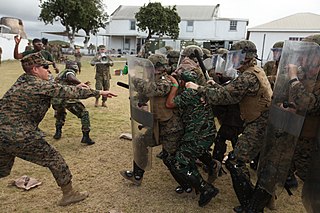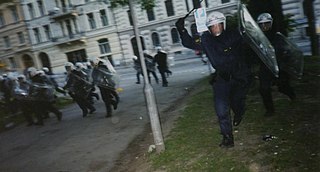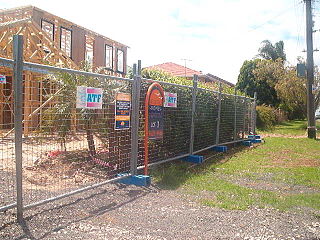
The Hillsborough disaster was a fatal human crush at a football match at Hillsborough Stadium in Sheffield, South Yorkshire, England, on 15 April 1989. It occurred during an FA Cup semi-final between Liverpool and Nottingham Forest in the two standing-only central pens in the Leppings Lane stand allocated to Liverpool supporters. Shortly before kick-off, in an attempt to ease overcrowding outside the entrance turnstiles, the police match commander, David Duckenfield, ordered exit gate C to be opened, leading to an influx of supporters entering the pens. This resulted in overcrowding of those pens and the crush. With 97 deaths and 766 injuries, it has the highest death toll in British sporting history. Ninety-four people died on the day; another person died in hospital days later, and another victim died in 1993. In July 2021, a coroner ruled that Andrew Devine, who died 32 years later, after suffering severe and irreversible brain damage on the day, was the 97th victim. The match was abandoned and restaged at Old Trafford in Manchester on 7 May 1989; Liverpool won and went on to win that season's FA Cup.

Riot control measures are used by law enforcement, military, paramilitary or security forces to control, disperse, and arrest people who are involved in a riot, unlawful demonstration or unlawful protest.
The Hillsborough Stadium Disaster Inquiry report is the report of an inquiry which was overseen by Lord Justice Taylor, into the causes of the Hillsborough disaster in Sheffield, South Yorkshire, England, on 15 April 1989, as a result of which, at the time of the report, 95 Liverpool fans had died. An interim report was published in August 1989, and the final report was published in January 1990.

A bouncer is a type of security guard, employed at licensed or sanctioned venues such as bars, nightclubs, cabaret clubs, stripclubs, casinos, hotels, billiard halls, restaurants, sporting events, schools, concerts, balls or movie theaters. A bouncer's duties are to provide security, to check legal age and drinking age, to refuse entry for intoxicated persons, and to deal with aggressive, violent or verbal behavior or disobedience with statutory or establishment rules. They are also charged with maintaining order, and ensuring all laws and regulations are being followed by all patrons.

Mounted police are police who patrol on horseback or camelback. Their day-to-day function is typically picturesque or ceremonial, but they are also employed in crowd control because of their mobile mass and height advantage and increasingly in the UK for crime prevention and high visibility policing roles. The added height and visibility that the horses give their riders allows officers to observe a wider area, and it also allows people in the wider area to see the officers, which helps deter crime and helps people find officers when they need them. When employed for crowd control, there is a risk that some people may be trampled. The officer riding the horse might or might not be held legally responsible for injuries depending upon the totality of the circumstances.

An electric fence is a barrier that uses electric shocks to deter people and/or other animals from crossing a boundary. The voltage of the shock may have effects ranging from discomfort to death. Most electric fences are used for agricultural fencing and other forms of non-human animal control, although they are also used to protect high-security areas such as military installations or prisons, where potentially-lethal voltages may be used. Virtual electric fences for livestock using GPS technology have also been developed.

A stanchion is a sturdy upright fixture that provides support for some other object. It can be a permanent fixture.

A riot shield is a lightweight protection device, typically deployed by police and some military organizations, though also utilized by protestors. Riot shields are typically long enough to cover an average-sized person from the top of the head to the knees, though smaller one-handed models may also be used. They are generally intended to be used in riot control, to protect the user from melee attacks with blunt or edged weapons and also thrown projectiles, or non-lethal weapons such as rubber bullets and water cannons. They can also be used as short-ranged melee weapons to push back the opposing force. Most riot shields do not offer ballistic protection; ballistic shields are instead used in situations where heavily armed resistance is expected.

A baton charge is a coordinated tactic for dispersing crowds of people, usually used by police, paramilitary or military in response to public disorder. In the Indian subcontinent, a long bamboo stick, called lathi in Hindi and Urdu, is used for crowd control, and the expression lathi charge commonly employed to describe the action.

Temporary fencing is a free standing, self-supporting fence panel. The panels are held together with couplers that interlock panels together making it portable and flexible for a wide range of applications. A common type of temporary fencing is Heras fencing.
A Police Support Unit or PSU is a unit of police officers who have undergone specialist tactical training in Public Order and Riot Control.

The Garda Public Order Unit – commonly known as the Garda Riot Squad – is a unit of the Garda Síochána, Ireland's police force, that deals with public disorder, including riots and protests.

The 2007 A.S. Roma–Manchester United conflict occurred on 4 April 2007 at the Stadio Olimpico during the 2006–07 UEFA Champions League quarter-final match between Roma and Manchester United. In the conflict, missiles were thrown over a perspex barrier separating the two sets of supporters, which prompted the Italian riot police to enter and attempt to subdue the hostile crowd. The incident has been controversial, as the police and team supporters on both sides view the causes of and reactions to the melee differently.

The Federal Reserve Unit, or better known by the abbreviation as FRU, is a riot control force and a paramilitary special response team that can be deployed at any time to engage in any emergency or public unrest in Malaysia.
The term "snatch squad" refers to two tactics used by police in riot control and crowd control.
Sir Norman George Bettison, QPM is a British former police officer and the former Chief Constable of West Yorkshire Police. He resigned in October 2012 amidst controversy about his role in the Hillsborough disaster, in which he was involved in the implementation of a cover-up of police errors. He remained the subject of an Independent Police Complaints Commission (IPCC) investigation, and was charged on the 28 June 2017 with four counts of misconduct in public office. The case was dropped on 21 August 2018. Bettison's own book Hillsborough Untold (2016) contains his version of events.

A blast ball, also known as a tear gas ball, rubber ball grenade, or stinger grenade, is a ball-shaped, rubber coated, less-lethal grenade designed for law enforcement and riot control applications. A blast ball is similar to a stun grenade in that, when detonated, it generates a loud noise and bright light; however, it also releases a chemical irritant and occasionally also rubber pellets or fragments.
The 2009 Millennium Point Concert Stampede was an incident which occurred during a November 15, 2009 holiday event outside of the Millennium Point complex in Birmingham, United Kingdom. Hundreds of people broke through a temporary crowd control barrier causing various injuries to fans during the annual Christmas Lights Switch-On event, while JLS were performing.
Hillsborough is a 2014 documentary about the Hillsborough disaster. Directed and produced by Daniel Gordon, the two-hour film chronicles the disaster, the investigations, and their lingering effects; it also includes interviews with survivors, victims' relatives, police officers and investigators. It was co-produced by ESPN and BBC, first airing as a part of ESPN's series of sports films entitled 30 for 30, under the heading "Soccer Stories". Hillsborough aired in the United States on ESPN on 15 April 2014, the 25th anniversary of the disaster. The documentary could not be shown in the United Kingdom when it originally aired in 2014, due to the High Court inquest of 2012 still being in progress. However, after the verdict of the inquest had been announced, the BBC aired the documentary on 8 May 2016, with additional footage from the inquest and final verdict.

Crowd collapses and crowd crushes are catastrophic incidents that can occur when a body of people becomes dangerously overcrowded. When numbers are up to about five people per square meter, the environment may feel cramped but manageable; when numbers reach between eight and ten people per square meter, individuals become pressed against each other and may be swept along against their will by the motion of the crowd. Under these conditions, the crowd may undergo a progressive collapse where the pressure pushes people off their feet, resulting in people being trampled or crushed by the weight of other people falling on top of them. At even higher densities, the pressure on each individual can cause them to be crushed or asphyxiated while still upright.















